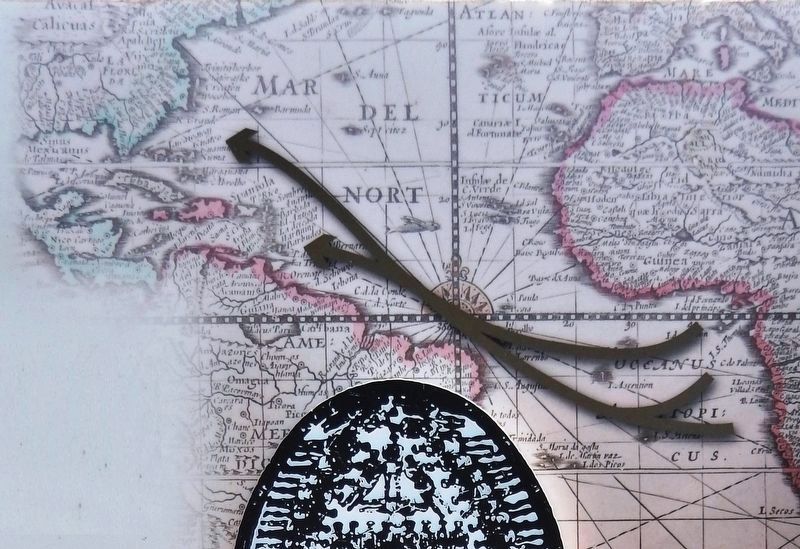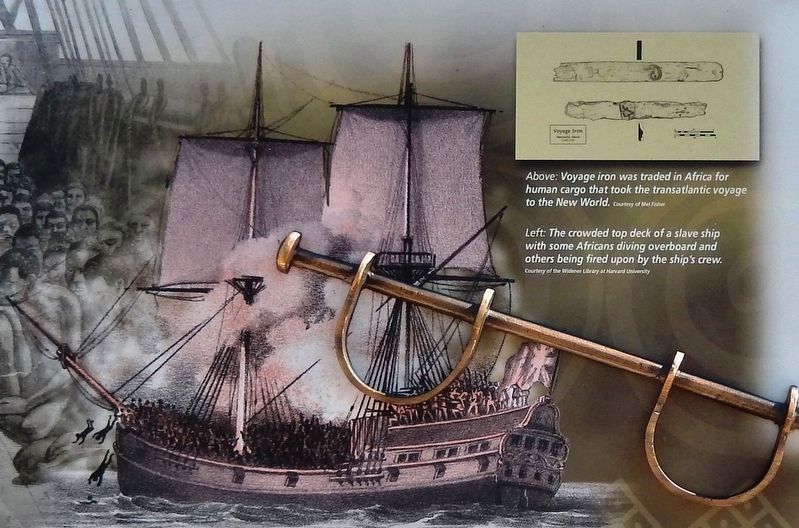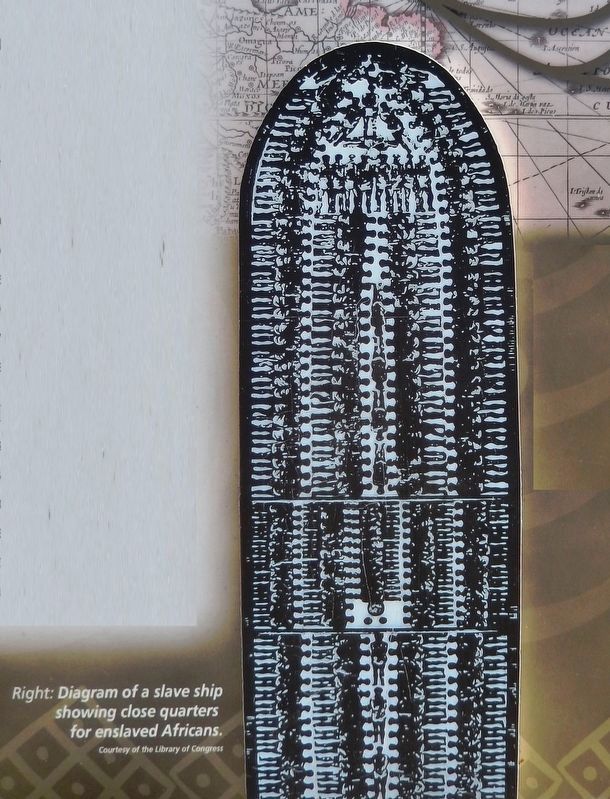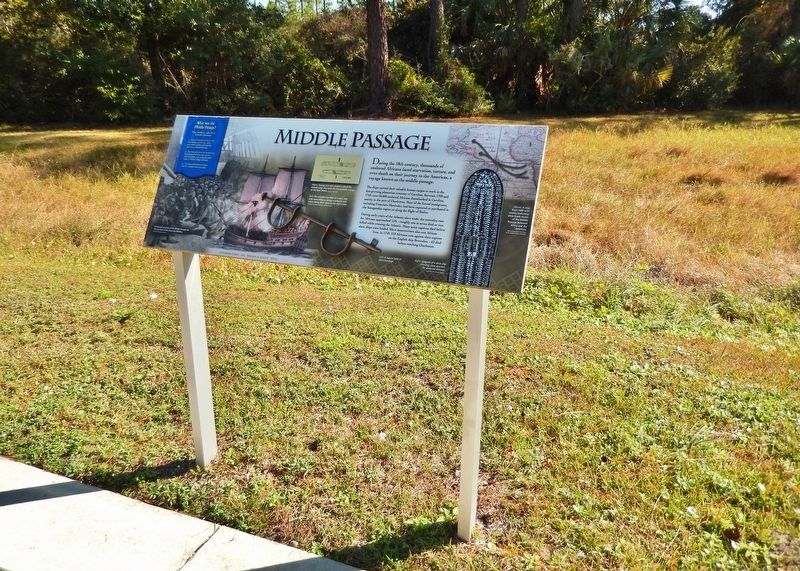St. Augustine in St. Johns County, Florida — The American South (South Atlantic)
Middle Passage
Fort Mose Historic State Park
What was the Middle Passage?
The Middle Leg of a 3-part Voyage:
1 • Ships left Europe for Africa, with trade goods, such as iron, cloth, glass beads, brandy, and firearms, used to buy enslaved Africans.
2 • The ships left Africa for the Americas, with enslaved Africans later sold for American goods, such as Spanish silver, tobacco, lumber, indigo, and sugar.
3 • The ships sailed back to Europe with the valuable American goods.
The ships carried their valuable human cargos to work in the fast-growing plantation economy of Carolina. Between 1709 and 1760, over 50,000 enslaved Africans disembarked in Carolina, mainly in the port of Charleston. Most of the forced immigrants, including Francisco Menéndez, had been captured or purchased in the Senegambia region or along the Bight of Biafra.
During early years of the Atlantic slave trade, the mortality rate for Africans approached 15% — roughly one in seven died or was killed while crossing the Atlantic. Many more captives died before slave ships were loaded. Slave insurrections also cost African lives. In 1749, 218 Africans rose against their captors on the English ship Brownlow — 62 died before reaching Charleston.
Topics. This historical marker is listed in these topic lists: African Americans • Colonial Era • Waterways & Vessels. A significant historical year for this entry is 1709.
Location. 29° 55.713′ N, 81° 19.52′ W. Marker is in St. Augustine, Florida, in St. Johns County. Marker is on Fort Mose Trail, 0.2 miles east of North Ponce De Leon Boulevard (U.S. 1), on the right when traveling north. Marker is within Fort Mose Historic State Park, beside the sidewalk leading from the parking lot to the visitor center. Touch for map. Marker is at or near this postal address: 15 Fort Mose Trail, Saint Augustine FL 32084, United States of America. Touch for directions.
Other nearby markers. At least 8 other markers are within walking distance of this marker. African Origins (here, next to this marker); British Enslavement (a few steps from this marker); Escape & Flight (a few steps from this marker); Fort Mose I (within shouting distance of this marker); El Pueblo de Gracia Real de Santa Teresa de Mose (within shouting distance of this marker); Bloody Mose (within shouting distance of this marker); Fort Mose II (within shouting distance of this marker); Evacuation (within shouting distance of this marker). Touch for a list and map of all markers in St. Augustine.
More about this marker. Marker is a large, rectangular composite plaque, mounted
horizontally on waist-high posts.
Related markers. Click here for a list of markers that are related to this marker. Fort Mose Historic State Park
Also see . . .
1. The African Slave Trade and the Middle Passage. Along the west coast of Africa, from the Cameroons in the south to Senegal in the north, Europeans built some sixty forts that served as trading posts. European sailors seeking riches brought rum, cloth, guns, and other goods to these posts and traded them for human beings. This human cargo was transported across the Atlantic Ocean and sold to New World slave owners, who bought slaves to work their crops. (Submitted on December 1, 2018, by Cosmos Mariner of Cape Canaveral, Florida.)
2. The Middle Passage. Two by two the men and women were forced beneath deck into the bowels of the slave ship. The "packing" was done as efficiently as possible. The captives lay down on unfinished planking with virtually no room to move or breathe. Elbows and wrists will be scraped to the bone by the motion of the rough seas. Upon reaching the West Indies, the slaves were fed and cleaned in the hopes of bringing a high price on the block. Those that could not be sold were left for dead. The slaves were then transported to their final destination. It was in this unspeakable manner that between ten and twenty million Africans were introduced to the New World. (Submitted on December 1, 2018, by Cosmos Mariner of Cape Canaveral, Florida.)
3. Middle Passage. Slaver captains anchored chiefly off the Guinea Coast (also called the Slave Coast) for a month to a year to trade for their cargoes of 150 to 600 persons, most of whom had been kidnapped and forced to march to the coast under wretched conditions. So that the largest possible cargo might be carried, the captives were wedged belowdecks, chained to low-lying platforms stacked in tiers, with an average individual space allotment that was 6 feet long, 16 inches wide, and perhaps 3 feet high. Unable to stand erect or turn over, many slaves died in this position. (Submitted on December 1, 2018, by Cosmos Mariner of Cape Canaveral, Florida.)
Credits. This page was last revised on January 2, 2019. It was originally submitted on December 1, 2018, by Cosmos Mariner of Cape Canaveral, Florida. This page has been viewed 384 times since then and 40 times this year. Photos: 1, 2, 3, 4, 5. submitted on December 1, 2018, by Cosmos Mariner of Cape Canaveral, Florida. • Andrew Ruppenstein was the editor who published this page.




